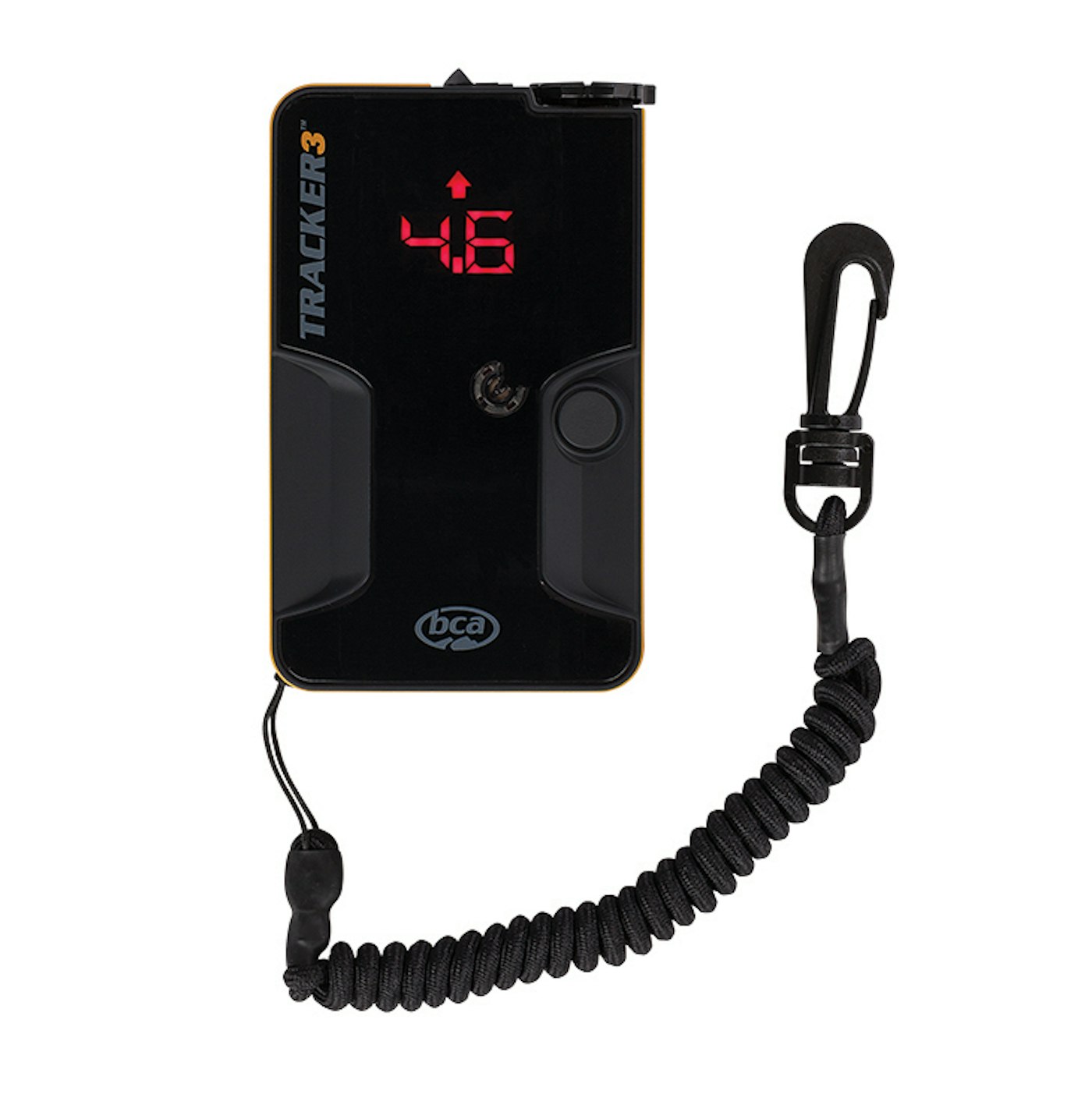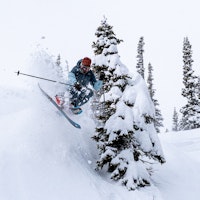The Experts at Ortovox Shed Light on Avalanche Beacon Functionality and Stress the Importance of Three-Antennae
Like most of your avalanche rescue tools, the transceiver, otherwise known as a beacon, is a device that you hope to never use in the field—except in a training scenario. Having a solid understanding of how your avy equipment works is paramount, and there’s hardly a tool more difficult to truly understand than this minuscule device. Read up on the intricacies of the avalanche beacon, below, and above all else, remember that nothing is a legitimate substitute for practice, practice, practice.
What is an Avalanche Beacon?
A transceiver, by definition, is able to transmit and receive radio frequencies. The device is basically a radio antenna that transmits and receives on a specific frequency of 457 Kilohertz (KHZ); i.e. it broadcasts and searches on this specific (457 KHZ) frequency.
Analog Out. Digital In.
When avalanche beacons were first developed they received with just one antenna and, because of that, required relatively inefficient search protocols. Using this primitive tool, an individual seeking a buried party would sweep the “analog,” or single antenna, beacon back and forth until the antenna best lined up with the transmitting (buried) beacon’s signal; when the searching device was best in-line with the transmitting device, audio tones would increase in volume inside of an integrated earpiece. The rescuer would then proceed in the direction of the loudest tone.
Today, “digital” beacons are the norm and deliver superior performance when it comes to locating buried skiers, climbers, snowmobilers, etc. A digital beacon is able to process the analog signal because it is built with multiple antennae—either two or three. In a two-antennae beacon, the X (the transmitting antenna) and Y antenna operate on the horizontal plane—i.e. what’s out in front of you, rather than above or below—and are used to display range and direction.
“Your beacon is receiving with a certain signal strength from both antennae,” explains Tom Mason, brand manager for Ortovox, one of the leading backcountry safety equipment manufacturers. “Now, it can calculate the difference between those two signal strengths into a direction, with an arrow [displayed on a beacon’s LED screen] pointing one way, conveying the strongest signal is ‘that way.’”
As a result, you don’t have to move the transceiver back and forth like in the older days and can proceed in the direction of the arrow to make your distance markers smaller and smaller, ultimately locating a buried victim. Analog beacons should be retired, plain and simple. In a nod to this idea, Ortovox runs a program where old beacons can be exchanged towards a $75 credit for the brand’s top-of-the-line 3+ transceiver.
Flux Lines
The radio waves transmitted by beacons are not traveling in a straight line; rather the pulses are emitted along what’s called the flux line. Ortovox’s Mason uses the analogy of an apple to explain this. “I use the apple because it is in three dimensions,” he explains. “The core of the apple would be the antenna and it’s pulsing out in that apple shape at 457 Kilohertz.” When your beacon picks up a signal and points you in a direction, it’s directing you towards the signal it’s receiving along the flux line, not the exact direction of the transmitting beacon. The numbers displayed on the searcher’s beacon, in meters, are meant to guide that rescuer in the shortest distance to the signal along those curved lines.
2 Antennae vs. 3 Antennae
Two-antennae beacons were the standard market option just a few short years ago. They are far superior to analog beacons yet they come with a downside. During a “fine search,” (i.e. when a rescuer is close to the victim) the strongest signal, where the flux line intersects the snow surface at a 90-degree angle, will lead a searcher to a point that is not directly above the victim. This is called a “spike,” “null” or “false positive.”
A three-antennae beacon utilizes the “Z” antenna—a small antenna placed perpendicular to the X and Y—to account for this potentially deadly shortcoming. The Z antenna activates as the searching beacon gets closer to the victim and is meant to get rid of these spikes. Three antennae beacons are more expensive than those with two and the cost is well worth a skier’s dollar—after all, can you put a price on saving lives?

To further stress the importance of using a three-antennae beacon, consider that when victims are buried in a vertical orientation, the X antenna will transmit a signal that won’t be immediately picked up by the searching transceiver. “You can end up with your transmitting antenna in a vertical or predominantly vertical orientation. This makes the flux lines go up into space. Therefore, the range of the searching beacon is reduced dramatically,” says Mason.
To account for this, Ortovox developed its patented Smart Antenna Technology, utilized in all of its avalanche beacons. Smart Antenna recognizes the vertical orientation and switches transmission to the Y antenna, thus reverting transmission back to the horizontal plane. “An analogy we use is with smartphones. You know, you tilt your smartphone and the picture flips, it knows which way is up,” Mason explains. “It will acquire my signal in the best position or earliest in the search phase, so it’s a huge time saver.”
Avalanche Beacon Buzzwords
There are many terms that one can expect to encounter when purchasing a new avalanche beacon. One of the most common is “range.” The range is the distance at which a viable transmission can be received by the beacon.
“Flagging,” “suppressing” and “marking” are all words that essentially mean the same thing. In a multiple burial scenario, a signal suppression function allows a searcher to mark the location of a found victim so they can focus on the next buried signal.
“Real time display” is another commonly used phrase. In reality, all beacons have a real time display. “There’s an international standard of how many pulses a beacon may transmit per minute; it has to fall within specified criteria,” explains Mason. “Since there’s a standard that says you can only transmit at so many pulses per minute, everybody on the market has the same ability to diagnose pieces of information in the same amount of time.”
Interference
In today’s world it’s harder and harder to rip ourselves away from our electronics. Devices like iPhones, action cameras, DSLR cameras, etc. can all interfere with the transmission of an avalanche beacon. Beware!
“Ortovox’s literature says that your transmitting transceiver should be 20 centimeters away from any electronic device and 50 centimeters away during a search,” says Mason. “The interference makes the signal less clean. The best scenario is to turn those ‘things’ off.”
Practice
Beacons are lifesaving pieces of equipment, but are useless if the person using them is unfamiliar with proper search and rescue protocol. Real world scenarios aren’t the same as testing trials in a vacuum. Familiarize yourself with your tools, study avalanche forecasts, be smart and safe.
“You don’t want to be using your beacon for the first time in a rescue scenario,” Mason advises. “People think that they are perfect all of the time. They’re good, but that doesn’t mean that we shouldn’t practice on a regular basis.”
Recommended Gear:

As with other Ortovox beacons, the 3+’s best feature is its Smart Antenna Technology. This allows it to transmit via either the X or Y antenna, based on the orientation its wearer is buried in. This helps the transmission to be picked up quicker if vertically buried. Auto-revert and multiple burial marking are also included with the 3+.

The Micro is unique in two ways. First, it’s the smallest, lightest three-antenna beacon on the market. Second, rather than utilizing a switch to change between transmit and search, the user must simply take it out of its holster and it will switch to search mode. In addition, the Micro has an auto-revert function and is able to mark multiple burials during a group rescue.

The three-antennae Tracker3 is 20 percent smaller and lighter than its Tracker2 predecessor, for a less cumbersome feel. The Tracker3 allows for temporary signal suppression during multiple burials and automatically reverts from search to transmit if a user ceases motion during a rescue. This accounts for a secondary avalanche and burial.


![[GIVEAWAY] Win a 4-Night Karma Campervan Rental and go Ski the Powder Highway](https://www.datocms-assets.com/163516/1767816935-copy-of-dji_0608-1.jpg?w=200&h=200&fit=crop)

![[GIVEAWAY] Win a Legendary Ski Trip with Icelantic's Road to the Rocks](https://www.datocms-assets.com/163516/1765233064-r2r26_freeskier_leaderboard1.jpg?auto=format&w=400&h=300&fit=crop&crop=faces,entropy)

![[GIVEAWAY] Win a 4-Night Karma Campervan Rental and go Ski the Powder Highway](https://www.datocms-assets.com/163516/1767816935-copy-of-dji_0608-1.jpg?auto=format&w=400&h=300&fit=crop&crop=faces,entropy)




